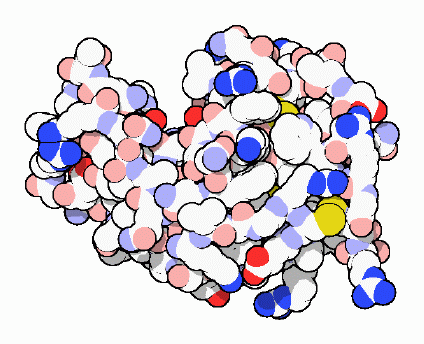|
Inhaltsübersicht | Nanomaschinen | Moleküle | Programme | Kurse | Fun | Links |
||
| > |
Lysozyme

Attacking Bacteria
Lysozyme protects us from the ever-present danger of bacterial infection. It is a small enzyme that attacks the protective cell walls of bacteria. Bacteria build a tough skin of carbohydrate chains, interlocked by short peptide strands, that braces their delicate membrane against the cell's high osmotic pressure. Lysozyme breaks these carbohydrate chains, destroying the structural integrity of the cell wall. The bacteria burst under their own internal pressure.
The First Antibiotic
Alexander Fleming discovered lysozyme during a deliberate search for medical antibiotics. Over a period of years, he added everything that he could think of to bacterial cultures, looking for anything that would slow their growth. He discovered lysozyme by chance. One day, when he had a cold, he added a drop of mucus to the culture and, much to his surprise, it killed the bacteria. He had discovered one of our own natural defenses against infection. Unfortunately, lysozyme is a large molecule that is not particularly useful as a drug. It can be applied topically, but cannot rid the entire body of disease, because it is too large to travel between cells. Fortunately, Fleming continued his search, finding a true antibiotic drug five years later: penicillin.
A Cellular Guardian
Lysozyme protects many places that are rich in potential food for bacterial growth. The lysozyme pictured here is from hen egg whites, where it serves to protect the proteins and fats that will nourish the developing chick. It was the first enzyme ever to have its structure solved--you can find it in PDB entry 2lyz. Our tears and mucus contain lysozyme to resist infection of our exposed surfaces. Our blood is the worst place to have bacteria grow, as they would be delivered to all corners of the body. In the blood, lysozyme provides some protection, along with the more powerful methods employed by the immune system.
Next: A Molecular Laboratory
Last changed by: A.Honegger,